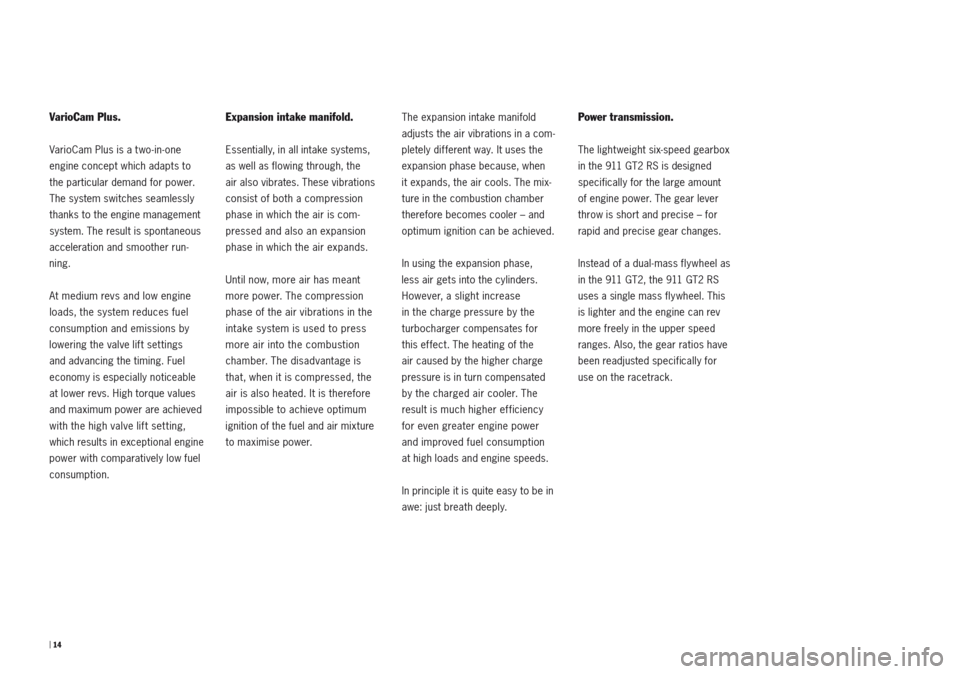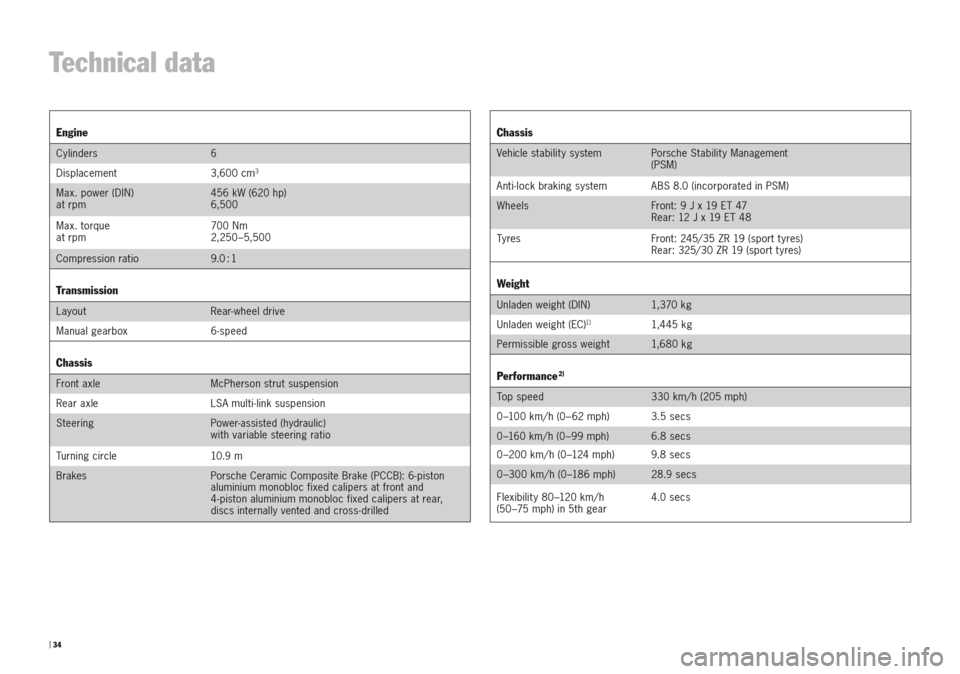compression ratio PORSCHE 911 GT2 2010 5.G Information Manual
[x] Cancel search | Manufacturer: PORSCHE, Model Year: 2010, Model line: 911 GT2, Model: PORSCHE 911 GT2 2010 5.GPages: 35, PDF Size: 3.73 MB
Page 11 of 35

| 14
VarioCam Plus.
VarioCam Plus is a two-in-one
engine concept which adapts to
the particular demand for power.
The system switches seamlessly
thanks to the engine management
system. The result is spontaneous
acceleration and smoother run-
ning.
At medium revs and low engine
loads, the system reduces fuel
consumption and emissions by
lowering the valve lift settings
and advancing the timing. Fuel
economy is especially noticeable
at lower revs. High torque values
and maximum power are achieved
with the high valve lift setting,
which results in exceptional engine
power with comparatively low fuel
consumption.
Expansion intake manifold.
Essentially, in all intake systems,
as well as flowing through, the
air also vibrates. These vibrations
consist of both a compression
phase in which the air is com-
pressed and also an expansion
phase in which the air expands.
Until now, more air has meant
more power. The compression
phase of the air vibrations in the
intake system is used to press
more air into the combustion
chamber. The disadvantage is
that, when it is compressed, the
air is also heated. It is therefore
impossible to achieve optimum
ignition of the fuel and air mixture
to maximise power.The expansion intake manifold
adjusts the air vibrations in a com-
pletely different way. It uses the
expansion phase because, when
it expands, the air cools. The mix-
ture in the combustion chamber
therefore becomes cooler – and
optimum ignition can be achieved.
In using the expansion phase,
less air gets into the cylinders.
However, a slight increase
in the charge pressure by the
turbocharger compensates for
this effect. The heating of the
air caused by the higher charge
pressure is in turn compensated
by the charged air cooler. The
result is much higher efficiency
for even greater engine power
and improved fuel consumption
at high loads and engine speeds.
In principle it is quite easy to be in
awe: just breath deeply.
Power transmission.
The light weight six-speed gearbox
in the 911 GT2 RS is designed
specifically for the large amount
of engine power. The gear lever
throw is short and precise – for
rapid and precise gear changes.
Instead of a dual-mass flywheel as
in the 911 GT2, the 911 GT2 RS
uses a single mass flywheel. This
is lighter and the engine can rev
more freely in the upper speed
ranges. Also, the gear ratios have
been readjusted specifically for
use on the racetrack.
Page 31 of 35

| 34
Technical data
Engine
Cylinders 6
Displacement 3,600 cm
3
Max. power (DIN)
at rpm 456 kW (620 hp)
6,500
Max. torque
at rpm 700 Nm
2,250 –5,500
Compression ratio 9.0 : 1
Transmission
Layout Rear-wheel drive
Manual gearbox 6-speed
Chassis
Front axle McPherson strut suspension
Rear axle LSA multi-link suspension
Steering Power-assisted (hydraulic)
with variable steering ratio
Turning circle 10.9 m
Brakes Porsche Ceramic Composite Brake (PCCB): 6-piston
aluminium monobloc fixed calipers at front and
4-piston aluminium monobloc fixed calipers at rear,
discs internally vented and cross-drilled
Chassis
Vehicle stability system Porsche Stability Management
(PSM)
Anti-lock braking system ABS 8.0 (incorporated in PSM)
Wheels Front: 9 J x 19 ET 47
Rear: 12 J x 19 ET 48
Tyres Front: 245/35 ZR 19 (sport t yres)
Rear: 325/30 ZR 19 (sport tyres)
Weight
Unladen weight (DIN) 1,370 kg
Unladen weight (EC)
1)1,4 45 k g
Permissible gross weight 1,680 kg
Performance2)
Top speed 330 km/ h (205 mph)
0–100 km/ h (0–62 mph) 3.5 secs
0–160 km/ h (0–99 mph) 6.8 secs
0–200 km/h (0–124 mph) 9.8 secs
0–300 km/h (0–186 mph) 28.9 secs
Flexibility 80–120 km/h
(50–75 mph) in 5th gear 4.0 secs